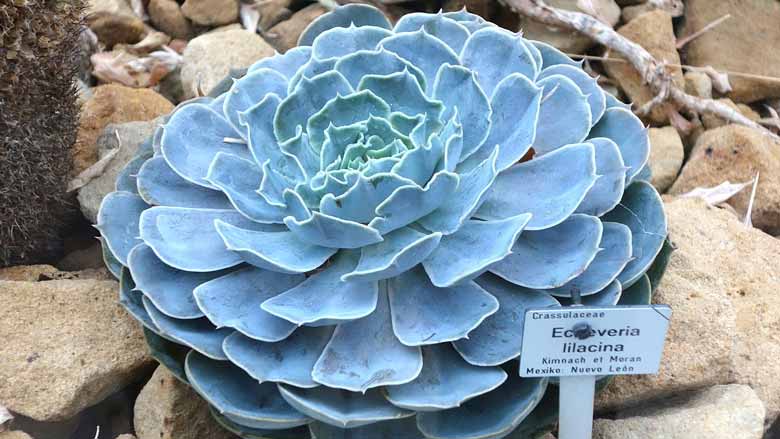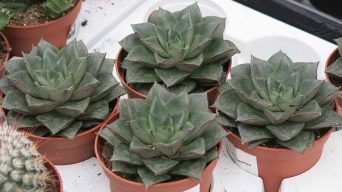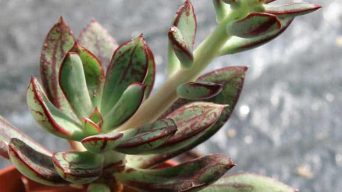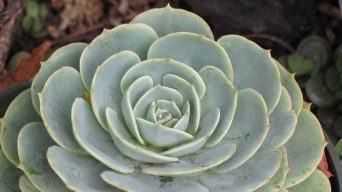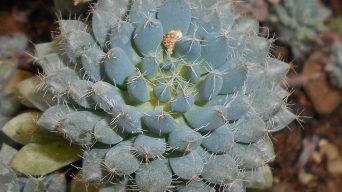Echeveria lilacina is a great succulent plant to learn how to take care of.
They are especially rewarding for beginning growers due to their ease of care requirements. This succulent is also known as the “Ghost Echeveria”, and it’s quite impossible to kill.
It’s among the hardiest and longest-lived plants, making them an excellent choice for people who don’t have much experience in taking care of plants and want something easy yet rewarding.
This article is a complete guide about taking care of and propagating the Echeveria lilacina ‘Ghost Echeveria’ plant.
Overview
Echeveria lilacina, also known as Ghost Echeveria or Mexican Hens and Chicks, is a succulent plant belonging to the family Crassulaceae. This Echeveria species is native to Nuevo Leon, Mexico’s northern state.
Echeveria lilacina is a medium-sized, slow-growing succulent with spoon-shaped leaves arranged in a symmetrical rosette that grows up to 6 inches (15 cm) tall and 7 inches (17.5 cm) in diameter.
The Ghost Echeveria leaves are silvery-grey, almost white, and have an iridescent blue tint.
This succulent plant is characterized by its slender, tall stalks and delicately colored blooms. The petals are usually pale pink to coral red with a white center.
Echeveria lilacina blooms from late winter to early spring.
How To Care for Echeveria Lilacina ‘Ghost Echeveria’
Echeveria lilacina is easy to care for and is very low maintenance.
Below you’ll find the most important information you need to know about caring for Echeveria lilacina ‘Ghost Echeveria’.
Sun Exposure & Light Requirements
The Ghost Echeveria is a succulent plant thriving in warm, sunny climates.
It requires at least six hours of full sun per day, and indoors it should be placed near a west- or east-facing window with plenty of bright light.
The plant should be in partial shade outdoors to avoid intense direct sunlight during the hottest parts of the day.
It can tolerate some more shade than other varieties of Echeveria, but it still needs plenty of sun for optimum growth.
Watering Requirements
When planted in the ground, Echeverias should be watered about once a week to every ten days, depending on the time of year.
If they are in pots, water them when they are dry to the touch. Echeveria plants do not like having wet feet, so always drain extra water after watering.
Echeveria is very drought tolerant, so it is best to let the soil dry out completely between watering when in a container.
Ensure not to overwater Echeveria because they rot quickly if their roots are too wet.
Echeveria plants should be watered only at the soil level, never on the leaves, so be careful about how much water is on the leaves.
They are very drought tolerant and will survive droughts which can kill other succulents.
Echeveria lilacina should not be watered too frequently during winter, only when the soil is completely dry. Water more regularly during the summer months.
Soil Requirements
The Echeveria lilacina succulent is tolerant of various soil types as long as they are well-draining.
This means the soil should consist of 50% potting soil and 50% coarse sand or gravel, with some perlite mixed in to ensure good drainage.
If you are unsure if your soil drains well enough, simply mix some perlite into the soil to improve drainage.
Many soil mixes work well for succulents, but the cactus potting mix works especially well. This type of soil can be purchased at most garden supply stores.
Make sure you do not use regular potting soil as it holds too much water and will kill your Ghost Echeveria succulents.
If your soil seems too wet, adding more perlite or sand to improve drainage is the best way to fix it.
Temperature and Humidity Requirements
The Echeveria lilacina is naturally found growing in dry areas.
During the day, the Ghost Echeveria plant needs a temperature range of 68° – 80° Fahrenheit (20 – 27°C), while at night it should be kept between 50° – 70° Fahrenheit (10 – 21°C).
Humidity levels need to be between 20 and 40%. If there is too much humidity in the air, it can lead to root rot.
Fertilizing
The Echeveria lilacina ‘Ghost Echeveria’ plant does not need to be fertilized, but occasional fertilizer in the growing season can be beneficial.
The best time to fertilize is in the early spring before growth begins. Do not fertilize after midsummer as this may cause new leaves to become yellow and fall off.
Use a balanced liquid fertilizer diluted to half-strength and apply it as a drench at the base of the plant.
Echeverias are sensitive to over-fertilization and generally do not need to be fertilized more than twice a year.
Potting and Repotting
The Echeveria lilacina plant must only be repotted when it outgrows its current pot or when the soil has all been washed away.
To remove the plant from its original pot, just pull the sides of the soil away from the root ball, being very careful not to harm or break roots.
If you are repotting, just put some fresh soil in the bottom of a pot and set the plant within, making sure to press down very softly around the plant to have some stability.
The ideal type of pot to plant it has drainage holes to allow the water to escape easily.
These pots are necessary because they enable excess water to drain out, ensuring your soil doesn’t get soggy and rot your plant’s roots.
Using a pot without drainage can lead to root rot, killing your plant within a few weeks.
Terracotta or unglazed pots are best for this plant because they naturally absorb water into the soil.
Glazed pots should be avoided due to their lack of porosity, which can affect drainage and cause water retention.
Pruning
In general, the Ghost Echeveria does not need to be pruned except to remove any dead leaves or flowers to prevent rot or diseases.
However, if the Echeveria has elongated and becomes leggy due to lack of sunlight, the stem should be cut back halfway down the stem.
Make sure a bud is nearby to grow new stems and leaves.
The leaves are easily removed by hand, but it is necessary to be careful when removing the top layer of the stem.
Be gentle when doing so, so the stem will not be damaged.
Pests and Diseases
Very few pests and diseases affect the Echeveria lilacina ‘Ghost Echeveria’ succulent.
One of the most common ones is mealybugs, which appear in the form of a cottony substance on leaves or roots.
This can be treated by repeatedly using neem oil or insecticidal soap until it has been eradicated.
Root rot is another one, and this happens because your Echeveria lilacina ‘Ghost Echeveria is sitting in wet soil or the air is too moist.
To prevent this from happening, make sure your Ghost Echeveria has good drainage and that you only water it when the soil is dry to the touch.
The last one is Botrytis, aka plant rot or bud rot, which appears as a grey/brown fuzzy mold on the stems of succulents.
This can be prevented by ensuring the humidity level in your home is low and you stop watering for a while to allow the soil to dry out.
If it appears, cut off all the diseased parts of the plant and remove them from the pot.
Wash your hands thoroughly after touching infected plants so as not to spread the disease to other plants.
How to Care for Echeveria Lilacina ‘Ghost Echeveria’ in Winter
Echeveria lilacina plants are not cold-hardy. This means you have to overwinter them by bringing them indoors before the first frost of the winter.
Although it is tolerable if you bring your Ghost Echeveria inside when the temperature drops down to 40°F (5°C), the ideal temperature for them is between 60 to 80°F (15-27°C).
You should try your best to keep the temperature around 70°F (21°C) or more to prevent stressing out your Ghost Echeveria.
Also, try to water moderately. Water the soil only when the soil feels dry to your touch. Do not let them sit in water, as they can rot from this.
In wintertime, you should cut back on watering and increase air circulation because of the colder temperature.
It usually is safe to keep your Ghost Echeveria outside during mild winters, but you need to bring them indoors during freezing weather.
After taking your plants in, make sure to overwinter them in a cool place where they get indirect light.
In springtime, when it starts getting warmer, you can move your plants back outside for some fresh air, but remember that if frost appears, you have to bring your plants back inside because these plants are not frost-resistant.
How To Propagate Echeveria Lilacina ‘Ghost Echeveria’
The Echeveria lilacina can be easily propagated via leaf cuttings and offsets.
How to Propagate Echeveria Lilacina by Leaf Cuttings
To propagate the Ghost Echeveria by leaf cuttings, remove a leaf from the rosette and place it in an area that receives bright indirect light.
Allow the leaf to dry and callous for a few days before planting it, with the cut side down, in a well-draining soil mixture.
Keep the soil moist until new growth emerges, and move the plant to a brighter area once new growth appears.
How to Propagate Echeveria Lilacina by Offsets
Offsets are the small rosettes that often grow on the mother plant.
To propagate the Ghost Echeveria via offsets, gently pull the offset away from the main rosette and replant it in a new pot with well-draining soil.
Place it in an area that receives bright indirect light and keep the soil moist until new growth emerges.
Final Thoughts
Growing succulents can be rewarding, and Echeveria lilacina is no exception.
Succulent plants prove versatile additions to gardens, thriving seamlessly in both indoor and outdoor settings due to their ability to acclimate to diverse environments.
Most people already have a little experience working with succulents, so this is an option if you are looking for something different on your next gardening adventure.
Echeveria lilacina, the Ghost Echeveria, is a lovely, low-maintenance plant that most people could learn to grow with relative ease.

